
Craigie Castle, Ayrshire
Encyclopedia
Craigie Castle in the old Barony of Craigie, is a ruined fortification
situated about 4 miles (6.4 km) southeast of Kilmarnock
and 1 miles (1.6 km) southeast of Craigie village, in the Parish of Craigie, South Ayrshire
, Scotland
.
The parish, including part of the ancient Barnweill
or Barnwell parish, was united to Riccarton
until 1647. The castle lies about 1.25 miles (2 km) west-south-west of Craigie church. It is protected as a category B listed building,, and a scheduled monument.
. The castle passed to John Wallace of Riccarton through marriage about 1371 as the last heir was a daughter. This line of the Ayrshire Wallaces then lived at Craigie Castle until they moved to Newton Castle in Ayr in 1588. Craigie Castle was then left to fall into ruin.
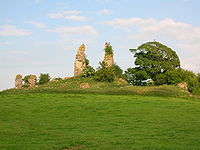
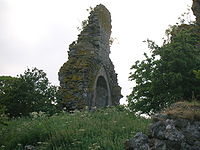
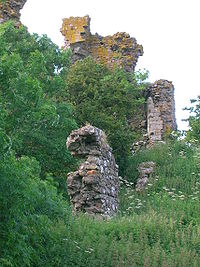 The present Gothic castellated ruins date mainly from the 15th century, with some 12th or 13th century work. Another view is that the main part of the building was a hall house dating from the 12th or 13th century, incorporating an even earlier building which may have been built by the predecessors of Walter Hose who held sway prior to Anglo-Norman control.
The present Gothic castellated ruins date mainly from the 15th century, with some 12th or 13th century work. Another view is that the main part of the building was a hall house dating from the 12th or 13th century, incorporating an even earlier building which may have been built by the predecessors of Walter Hose who held sway prior to Anglo-Norman control.
The buildings were surrounded by ditches and natural lochans; enclosing an area of about 4 acres (16,187.4 m²). It had a high quality rib-vaulted hall consisting of three bays over an unvaulted basement, but architectural historians have found traces of an earlier hall which had a crenellated parapet rising flush with the main wall-face. In the centre of one wall was a round-arched doorway, and opposite this a late medieval fireplace, added in the 15th century, was built over another round-arched opening.
The castle contains one of the finest examples of a vaulted hall in Scotland, easily equal to any Scottish abbey or church. The only rivals of the same period are Tulliallan, Bothwell
, and Auchendoun. It has been stated that in its time Craigie was the most impressive building of its kind in Ayrshire.
Due to the condition of the structures it has proved difficult to determine the original plan, but the remains suggest that it was originally a simple rectangle of suitable size for a building such as an early hall-house. Craigie Castle may originally have been a hall-house of the late 12th or early 13th century with a wide crenellate parapet enclosing a saddle-back roof. During the 15th century it seems that these crenellations were built over and a new hall fashioned on the walls of its predecessor.
The ruins stand upon a knoll rising out of a plateau, between what appears to have been two marshes or lochans, and the ditches were originally cut between them. One ditch cuts the ridge 117m NE of the castle to form an outer bailey. The castle would have been effectively isolated from the 'mainland', and a significant barrier raised by the water to any potential besiegers at the period when the use of gunpowder was unknown. Two crumbling gables, portions of walls, and shreds of battlements remain, and in the 19th century several underground vaulted chambers survived, although partly filled with rubbish, and home to foxes and bats. The entrance to the castle was at the south-west side by a drawbridge, of which the abutment still survives. The entrance pend or arched passage had a circular watch-tower or bastion to defend it. Within the closing wall was a courtyard surrounded by buildings, and from this courtyard there was an entrance into the great hall, long blocked up.
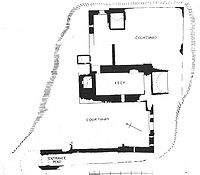 In 1895 Smith records that at a distance of 145 paces from to the north-east of the castle a deep trench has been cut in a north-west and south-east direction for a distance of 162 paces, to connect the two lochans. Near the south wall of the castle there is another trench, and a section of building is to be seen on the outside of it. On the west side there are the remains of a third trench.
In 1895 Smith records that at a distance of 145 paces from to the north-east of the castle a deep trench has been cut in a north-west and south-east direction for a distance of 162 paces, to connect the two lochans. Near the south wall of the castle there is another trench, and a section of building is to be seen on the outside of it. On the west side there are the remains of a third trench.
In 1863 Paterson records that the tower was undergoing some repairs at the end of the 17th century when a part of the roof fell in, after which the castle was completely abandoned. He praises the high degree of military science employed in the construction of the castle where besiegers would be exposed to raking crossfire even after crossing the ditches / moats and would be outflanked on nearly all sides.
A 'Kragy' castle is marked on Timothy Pont
's map of c.1600. It is shown on an elevated area with a prominent entrance way, wooded policies and a surrounding pale
.
Although now a minor road, the road running near the castle (B730) was the main route from Irvine to Dumfries via Sanquhar, with a nearby link to the Ayr–Kilmarnock road; Craigie was therefore on one of the few reasonable standard communication routes in the area in the 18th and earlier centuries. The numerous rigs
on Roy's 1747 map show that the whole area was intensively cultivated at the time.
was visible in the boggy hollow 'just to the south-west' of Craigie Castle; it was described as a slight rise in the meadow...mostly composed of stones. When the hollow was drained an oar was found.
s near Craigie village, Knockmarloch and Highlangside. The barony would originally have had a Moot or Justice Hill and a gallows hill
.
map as far back as the late 16th / early 17th century.
, an executive agency
of the Scottish Government, on 14 April 1971. Such buildings are considered to be "of regional or more than local importance", and gain legal protection against unauthorised demolition, extension or significant alteration.
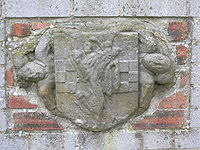
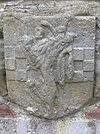 An armorial plaque from the castle ruins is set in the wall of the steading (NS 4 062 3174). The naive peasantry at one time believed that the stone showed two wild men playing at draughts. It bears the impaled arms of the Lindsays and Wallaces.
An armorial plaque from the castle ruins is set in the wall of the steading (NS 4 062 3174). The naive peasantry at one time believed that the stone showed two wild men playing at draughts. It bears the impaled arms of the Lindsays and Wallaces.
James Kilpatrick of Craigie Mains was a great horseman who considerably improved the breeding lines of the Clydesdale horse and was famous throughout Britain and the World. Some his champions were 1918, Craigie Litigant; 1921, Craigie Excellence; 1924, Craigie McQuaid; 1925, Craigie Exquisite; 1929, Craigie Winalot; 1930, Craigie Beau Ideal; 1933, Craigie Realisation; 1935, Craigie Magnificent; 1939, Craigie Independent; 1941, Craigie Topsman; 1942, Craigie Chieftain; 1947, Craigie Supreme Commander; 1948, Craigie True Form. In 1951 Craigie Mains had about 80 head of horses. James Kilpatrick regularly exhibited his Clydesdales, colts and fillies in all their finery at the annual Craigie Agricultural Show in the 1900s.
The famous 'Baron of Buchlyvie' was purchased for £700 by Mr Kilpatrick in 1902 and was the stud horse at the mains in 1903. Mr William Dunlop of Dunure Mains had a half share and after much disagreement the 'baron' ended up at Dunlop Mains, having been sold at auction or £9,500; an unheard of sum for a Clydsedale at the time. The mounted skelton of this horse is now on display at the Kelvingrove Art Gallery and Museum in Glasgow.
Matthew Anderson the 'Policeman Poet' wrote a poem in honour of Symington and Craigie.
This is an extract -


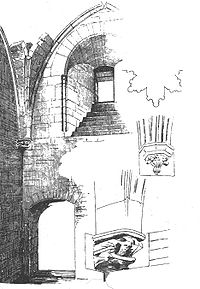 John Wallace of Riccarton in the reign of David II
John Wallace of Riccarton in the reign of David II
had a charter of lands of Moorlecere in Forfarshire and was styled 'Wallayis of Richardtoun'. John married the heiress of Lindsay of Craigie circa 1371 and from this date Craigie was the chief residence of the family.
John Wallace was Lieutenant-General to James II
, and fought at the Battle of Sark
in 1447, killing the English General Magnus with his own hands. John was injured on the battlefield and died of his wounds at Craigie Castle about three months later.
In the second half of the 15th century the Wallace family had Blind Harry
write his poem The Wallace
, which recorded the story of Sir William Wallace, albeit 150 years after his death.
An Adam Wallace was Comptroller of the Household of James III in 1468. John Wallace was killed at the Battle of Flodden in 1513; his brother Adam inherited and became oversmen of Prestwick
in addition to Bailie of Kyle Stewart. In 1515 he was made alderman of Ayr and controlled the Royal Burgh for a decade.
In 1559 Sir John Wallace accompanied the Earl of Glencairn, the Lords Boyd and Ochiltree, the Sheriff of Ayr, the Laird of Cessnock and others, with a body of 2500 men to Perth in support of the Covenanters or reformers
.
Sir William Wallace commanded a cavalry under James VII (James II of England) and went into exile in France with him. He was at the Battle of Killiecrankie
and died circa 1700; his brother succeeded to the estates, much impoverished by Sir William's adherence to the Jacobite cause.
The Wallaces of Craigie became hereditary Bailies of Kyle Stewart and as such were the chief local representatives of the Crown. In 1489 John Wallace obtained a lease to mine coal near Kingcase in Prestwick.
In 1527 Gilbert Kennedy, 2nd Earl of Cassillis was ambushed and murdered on the sand dunes at Prestwick. Adam Wallace was implicated in this essentially Campbell inspired feud, as his wife, Dame Isabelle, was said to have planned the assassination. The controversy resulted in a loss of prestige and influence.
Sir Hugh Wallace was a supporter of the Royalist cause of Charles I and II, for which his estate was sequestered and only returned when Charles II
came to the throne. Sir Hugh had raised a regiment of foot at his own expense, resulting in great debts, sale of lands and in 1626 the disposal of the heritable Kyle bailieship to the Crown for £10,000 Scots. Sir Hugh Wallace, the laird referred to below, was knighted by Charles I
and in 1669 Charles II conferred a Baronetcy upon him. All his sons predeceased him and Thomas, a grandnephew inherited. He was most liberal in his ideas, fought with Montrose
at the Battle of Philiphaugh
and died about 1650.
In 1770 Sir Thomas Wallace died and the baronetcy was inherited by his grandson Thomas Dunlop, who sold off the estate of Craigie in 1783, moved to England and died within three years. He adopted the name Wallace, his mother being Frances Anne Wallace of Dunlop, Sir Thomas's daughter and sole heir; his father was John Dunlop of that Ilk. His son was Major-General Sir John Alexander Wallace who fought in India, Egypt, Spain and France and died in 1857.
The Wallaces married into a number of local aristocratic families, notably the Campbells of Loudoun and the Blairs of Blair. At Blair Castle above a door are the armorial bearings of the Blairs Of Blair and the Wallaces of Craigie, dated 1617. Bryce Blair married Annabel Wallace.
In the 1560s the Wallace family acquired Fail Monastery
, however it was later granted to Walter Whytford and passed out of their hands.
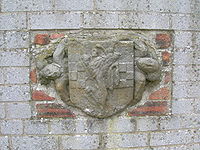 Those of Sir John Alexander Wallace were quarterly : first and fourth, Gules
Those of Sir John Alexander Wallace were quarterly : first and fourth, Gules
, a Lion rampant, Or
, within an Orle
; second and third, Gules, a fesse Cheque of three, Argent
and Azure
. The Supporters were two savages, proper, with Clubs erect. The family crest was an Ostrich neck and head erect, issuing out of an open crown, with a horseshoe in the mouth. The motto was Esperanza
, Spanish for 'Hope'.
The Laird ignored the ministers' advice and when in church he actually threw his sword at the minister, the sword sticking in the wood at the back of the pulpit. The minister recovered and told the Laird that God will reduce your great stone house to a pile of stones and no one will be able to repair it; and your son, of whom you have great hopes, will die a fool. Before long the castle was in need of repair, and when the stonemasons started work a great part of it fell down and had almost buried them all. The story may have a grain of truth as Sir Hugh, as stated, was an ardent supporter of the episcopalian
sentiments of Charles I and II and was no friend of the Presbyterians.
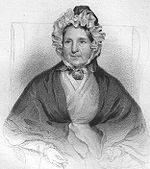 In the 1730s, Craigie House (NGR NS 34970 21386) in Ayr was built as a replacement residence for Sir Thomas Wallace of Newton-on-Ayr Castle, the fifth baronet; nothing of Newton Castle, previously known as Sanquhar, now remains. In 1783 William Campbell, who made his fortune in India, purchased the principal portion of the Craigie estate. His brother, Richard Campbell of Craigie inherited the estate in 1823 and the property remained in the Campbell family for a number of generations. The family included lawyers and politicians, one being the Member for the Ayr Burghs.
In the 1730s, Craigie House (NGR NS 34970 21386) in Ayr was built as a replacement residence for Sir Thomas Wallace of Newton-on-Ayr Castle, the fifth baronet; nothing of Newton Castle, previously known as Sanquhar, now remains. In 1783 William Campbell, who made his fortune in India, purchased the principal portion of the Craigie estate. His brother, Richard Campbell of Craigie inherited the estate in 1823 and the property remained in the Campbell family for a number of generations. The family included lawyers and politicians, one being the Member for the Ayr Burghs.
Craigie House and estate was purchased from the Campbell family by Ayr Town Council in 1940. The gardens that run from the centre of Ayr northeast alongside the River Ayr are open to the public free of charge, however the house is used as offices for the University of the West of Scotland and various building works are proposed for the gardens area.
The small loch below the manse was used as the curling pond in the 1900s; the Curling House
ruins are still standing (2009).
in 1584 William Wallace of Ellerslie held the lands of Mains of Helentoun and Bogend, together with the tower, fortalice, and manor place of Helenton
, together with half of the mill.
Fortification
Fortifications are military constructions and buildings designed for defence in warfare and military bases. Humans have constructed defensive works for many thousands of years, in a variety of increasingly complex designs...
situated about 4 miles (6.4 km) southeast of Kilmarnock
Kilmarnock
Kilmarnock is a large burgh in East Ayrshire, Scotland, with a population of 44,734. It is the second largest town in Ayrshire. The River Irvine runs through its eastern section, and the Kilmarnock Water passes through it, giving rise to the name 'Bank Street'...
and 1 miles (1.6 km) southeast of Craigie village, in the Parish of Craigie, South Ayrshire
South Ayrshire
South Ayrshire is one of 32 council areas of Scotland, covering the southern part of Ayrshire. It borders onto East Ayrshire, North Ayrshire and Dumfries and Galloway....
, Scotland
Scotland
Scotland is a country that is part of the United Kingdom. Occupying the northern third of the island of Great Britain, it shares a border with England to the south and is bounded by the North Sea to the east, the Atlantic Ocean to the north and west, and the North Channel and Irish Sea to the...
.
The parish, including part of the ancient Barnweill
Barnweill Church
Barnweill Church is a ruined pre-reformation kirk situated on rising ground on the slopes of Barnweill Hill, Parish of Craigie, South Ayrshire, Scotland; about 3km from Tarbolton. The church was known locally as the "Kirk in the Wood". It lies about 170m North North-East of Kirkhill Farm...
or Barnwell parish, was united to Riccarton
Riccarton, Ayrshire
Riccarton is a village and parish in East Ayrshire, Scotland. It lies across the River Irvine from Kilmarnock. The river Irvine divides the parishes of Riccarton and Kilmarnock and the river used to form the boundary between the districts of Kyle and Cunninghame.- History :The village became a...
until 1647. The castle lies about 1.25 miles (2 km) west-south-west of Craigie church. It is protected as a category B listed building,, and a scheduled monument.
History of Craigie Castle
Craigie Castle was originally built for the Lyndesay or Lindsay clanClan Lindsay
-Origins of the Clan:There is currently no known proven path pertaining to the origin of the Clan Lindsay. However, several possible theories have been advanced over the years. First is the theory proposed in 1769 by biographer/historian, Richard Rolt, in which he claimed that the Lindsays were...
. The castle passed to John Wallace of Riccarton through marriage about 1371 as the last heir was a daughter. This line of the Ayrshire Wallaces then lived at Craigie Castle until they moved to Newton Castle in Ayr in 1588. Craigie Castle was then left to fall into ruin.
Descriptions of the castle



The buildings were surrounded by ditches and natural lochans; enclosing an area of about 4 acres (16,187.4 m²). It had a high quality rib-vaulted hall consisting of three bays over an unvaulted basement, but architectural historians have found traces of an earlier hall which had a crenellated parapet rising flush with the main wall-face. In the centre of one wall was a round-arched doorway, and opposite this a late medieval fireplace, added in the 15th century, was built over another round-arched opening.
The castle contains one of the finest examples of a vaulted hall in Scotland, easily equal to any Scottish abbey or church. The only rivals of the same period are Tulliallan, Bothwell
Bothwell
Bothwell is a small town in the South Lanarkshire council area of Scotland. It lies on the north bank of the River Clyde, adjacent to Uddingston and Hamilton, nine miles east-south-east of Glasgow city centre....
, and Auchendoun. It has been stated that in its time Craigie was the most impressive building of its kind in Ayrshire.
Due to the condition of the structures it has proved difficult to determine the original plan, but the remains suggest that it was originally a simple rectangle of suitable size for a building such as an early hall-house. Craigie Castle may originally have been a hall-house of the late 12th or early 13th century with a wide crenellate parapet enclosing a saddle-back roof. During the 15th century it seems that these crenellations were built over and a new hall fashioned on the walls of its predecessor.
The ruins stand upon a knoll rising out of a plateau, between what appears to have been two marshes or lochans, and the ditches were originally cut between them. One ditch cuts the ridge 117m NE of the castle to form an outer bailey. The castle would have been effectively isolated from the 'mainland', and a significant barrier raised by the water to any potential besiegers at the period when the use of gunpowder was unknown. Two crumbling gables, portions of walls, and shreds of battlements remain, and in the 19th century several underground vaulted chambers survived, although partly filled with rubbish, and home to foxes and bats. The entrance to the castle was at the south-west side by a drawbridge, of which the abutment still survives. The entrance pend or arched passage had a circular watch-tower or bastion to defend it. Within the closing wall was a courtyard surrounded by buildings, and from this courtyard there was an entrance into the great hall, long blocked up.

In 1863 Paterson records that the tower was undergoing some repairs at the end of the 17th century when a part of the roof fell in, after which the castle was completely abandoned. He praises the high degree of military science employed in the construction of the castle where besiegers would be exposed to raking crossfire even after crossing the ditches / moats and would be outflanked on nearly all sides.
A 'Kragy' castle is marked on Timothy Pont
Timothy Pont
Timothy Pont was a Scottish topographer, the first to produce a detailed map of Scotland. Pont's maps are among the earliest surviving to show a European country in minute detail, from an actual survey.-Life:...
's map of c.1600. It is shown on an elevated area with a prominent entrance way, wooded policies and a surrounding pale
Pale
-Color:*Pale, an adjective meaning of a light shade or hue; approaching white*Paleness , a relative lightness of color*Pale, a variance of human skin color, especially:**Pallor, a symptom of low oxygen content in blood or avoidance of sunlight...
.
Although now a minor road, the road running near the castle (B730) was the main route from Irvine to Dumfries via Sanquhar, with a nearby link to the Ayr–Kilmarnock road; Craigie was therefore on one of the few reasonable standard communication routes in the area in the 18th and earlier centuries. The numerous rigs
Run rig
Run rig, or runrig, was a system of land occupation practised in northern and western Great Britain, especially Scotland. The name refers to the ridge and furrow pattern characteristic of this system , with alternating "runs" and "rigs" . The system continued in use into the 20th century in the...
on Roy's 1747 map show that the whole area was intensively cultivated at the time.
Crannog
As late as the 19th century a likely crannógCrannog
A crannog is typically a partially or entirely artificial island, usually built in lakes, rivers and estuarine waters of Scotland and Ireland. Crannogs were used as dwellings over five millennia from the European Neolithic Period, to as late as the 17th/early 18th century although in Scotland,...
was visible in the boggy hollow 'just to the south-west' of Craigie Castle; it was described as a slight rise in the meadow...mostly composed of stones. When the hollow was drained an oar was found.
Moot hills
Smith records moot hillMoot hill
A moot hill or mons placiti is a hill or mound historically used as an assembly or meeting place. In early medieval Britain, such hills were used for "moots", meetings of local people to settle local business. Among other things, proclamations might be read; decisions might be taken; court cases...
s near Craigie village, Knockmarloch and Highlangside. The barony would originally have had a Moot or Justice Hill and a gallows hill
Dule Tree
Dule or dool trees in Britain were used as gallows for public hangings. They were also used as gibbets for the display of the corpse for a considerable period of time after such hangings...
.
Borland Farms
Two Borland Farms are now located near Craigie village and this may relate directly to Craigie Castle. The name 'Boarland' could possibly refer to the presence of wild boar, however a more likely origin is that a 'Boor' also meant a serf and Norman lords often apportioned lands near their castles for their servants. The Borland or Bordland also meant the land that was specifically used to furnish food for a castle. A 'Boirland' is marked on the Timothy PontTimothy Pont
Timothy Pont was a Scottish topographer, the first to produce a detailed map of Scotland. Pont's maps are among the earliest surviving to show a European country in minute detail, from an actual survey.-Life:...
map as far back as the late 16th / early 17th century.
Listed status
Craigie Castle was listed at Category B by Historic ScotlandHistoric Scotland
Historic Scotland is an executive agency of the Scottish Government, responsible for historic monuments in Scotland.-Role:As its website states:...
, an executive agency
Executive agency
An executive agency, also known as a next-step agency, is a part of a government department that is treated as managerially and budgetarily separate in order to carry out some part of the executive functions of the United Kingdom government, Scottish Government, Welsh Assembly or Northern Ireland...
of the Scottish Government, on 14 April 1971. Such buildings are considered to be "of regional or more than local importance", and gain legal protection against unauthorised demolition, extension or significant alteration.
Craigie Mains farm


James Kilpatrick of Craigie Mains was a great horseman who considerably improved the breeding lines of the Clydesdale horse and was famous throughout Britain and the World. Some his champions were 1918, Craigie Litigant; 1921, Craigie Excellence; 1924, Craigie McQuaid; 1925, Craigie Exquisite; 1929, Craigie Winalot; 1930, Craigie Beau Ideal; 1933, Craigie Realisation; 1935, Craigie Magnificent; 1939, Craigie Independent; 1941, Craigie Topsman; 1942, Craigie Chieftain; 1947, Craigie Supreme Commander; 1948, Craigie True Form. In 1951 Craigie Mains had about 80 head of horses. James Kilpatrick regularly exhibited his Clydesdales, colts and fillies in all their finery at the annual Craigie Agricultural Show in the 1900s.
The famous 'Baron of Buchlyvie' was purchased for £700 by Mr Kilpatrick in 1902 and was the stud horse at the mains in 1903. Mr William Dunlop of Dunure Mains had a half share and after much disagreement the 'baron' ended up at Dunlop Mains, having been sold at auction or £9,500; an unheard of sum for a Clydsedale at the time. The mounted skelton of this horse is now on display at the Kelvingrove Art Gallery and Museum in Glasgow.
Matthew Anderson the 'Policeman Poet' wrote a poem in honour of Symington and Craigie.
This is an extract -
"The greatest place beneath the sky, For Clydesdale horse and Ayrshire Kye, In all the bliss of perfect joy, They roam the fields sae lovely. There's Craigie Mains and Laigh Langside, In them we feel a special pride, Their name and fame are World wide. Then hip, hurrah for Craigie!" |
The Hoses and Lindsays of Craigie
In the 12th century Walter fitz Alan, Steward of Scotland, held these lands and Walter Hose held his fief from the Steward. In 1177 Walter Hose of Cragyn had given the church of Cragyn to the monks of Paisley. John, probably Walter's son, inherited and his son Thomas had no heir, resulting in his sisters Christiana and Matilda inheriting. Walter de Lyndesay, Knight, was the son of Christiana, the father being William Lyndesey of Crawfurd. The male line ended with John de Lyndesey, whose daughter married John Wallace of Riccarton.The Wallaces of Craigie



David II of Scotland
David II was King of Scots from 7 June 1329 until his death.-Early life:...
had a charter of lands of Moorlecere in Forfarshire and was styled 'Wallayis of Richardtoun'. John married the heiress of Lindsay of Craigie circa 1371 and from this date Craigie was the chief residence of the family.
John Wallace was Lieutenant-General to James II
James II of Scotland
James II reigned as King of Scots from 1437 to his death.He was the son of James I, King of Scots, and Joan Beaufort...
, and fought at the Battle of Sark
Battle of Sark
The Battle of Sark was fought between England and Scotland in October 1448. A large battle, it was the first significant Scottish victory over the English in over half a century, following the Battle of Otterburn of 1388...
in 1447, killing the English General Magnus with his own hands. John was injured on the battlefield and died of his wounds at Craigie Castle about three months later.
In the second half of the 15th century the Wallace family had Blind Harry
Blind Harry
Blind Harry , also known as Harry, Hary or Henry the Minstrel, is renowned as the author of The Actes and Deidis of the Illustre and Vallyeant Campioun Schir William Wallace, also known as The Wallace...
write his poem The Wallace
The Actes and Deidis of the Illustre and Vallyeant Campioun Schir William Wallace
The Actes and Deidis of the Illustre and Vallyeant Campioun Schir William Wallace, also known as The Wallace, is a long "romantic biographical" poem by the fifteenth century Scottish makar of the name Blind Harry probably at some time in the decade before 1488...
, which recorded the story of Sir William Wallace, albeit 150 years after his death.
An Adam Wallace was Comptroller of the Household of James III in 1468. John Wallace was killed at the Battle of Flodden in 1513; his brother Adam inherited and became oversmen of Prestwick
Prestwick
Prestwick is a town in South Ayrshire on the south-west coast of Scotland, about south-west of Glasgow. It adjoins the larger town of Ayr, the centre of which is about south...
in addition to Bailie of Kyle Stewart. In 1515 he was made alderman of Ayr and controlled the Royal Burgh for a decade.
In 1559 Sir John Wallace accompanied the Earl of Glencairn, the Lords Boyd and Ochiltree, the Sheriff of Ayr, the Laird of Cessnock and others, with a body of 2500 men to Perth in support of the Covenanters or reformers
Scottish Reformation
The Scottish Reformation was Scotland's formal break with the Papacy in 1560, and the events surrounding this. It was part of the wider European Protestant Reformation; and in Scotland's case culminated ecclesiastically in the re-establishment of the church along Reformed lines, and politically in...
.
Sir William Wallace commanded a cavalry under James VII (James II of England) and went into exile in France with him. He was at the Battle of Killiecrankie
Battle of Killiecrankie
-References:*Reid, Stuart, The Battle of Kiellliecrankkie -External links:* *...
and died circa 1700; his brother succeeded to the estates, much impoverished by Sir William's adherence to the Jacobite cause.
The Wallaces of Craigie became hereditary Bailies of Kyle Stewart and as such were the chief local representatives of the Crown. In 1489 John Wallace obtained a lease to mine coal near Kingcase in Prestwick.
In 1527 Gilbert Kennedy, 2nd Earl of Cassillis was ambushed and murdered on the sand dunes at Prestwick. Adam Wallace was implicated in this essentially Campbell inspired feud, as his wife, Dame Isabelle, was said to have planned the assassination. The controversy resulted in a loss of prestige and influence.
Sir Hugh Wallace was a supporter of the Royalist cause of Charles I and II, for which his estate was sequestered and only returned when Charles II
Charles II of England
Charles II was monarch of the three kingdoms of England, Scotland, and Ireland.Charles II's father, King Charles I, was executed at Whitehall on 30 January 1649, at the climax of the English Civil War...
came to the throne. Sir Hugh had raised a regiment of foot at his own expense, resulting in great debts, sale of lands and in 1626 the disposal of the heritable Kyle bailieship to the Crown for £10,000 Scots. Sir Hugh Wallace, the laird referred to below, was knighted by Charles I
Charles I of England
Charles I was King of England, King of Scotland, and King of Ireland from 27 March 1625 until his execution in 1649. Charles engaged in a struggle for power with the Parliament of England, attempting to obtain royal revenue whilst Parliament sought to curb his Royal prerogative which Charles...
and in 1669 Charles II conferred a Baronetcy upon him. All his sons predeceased him and Thomas, a grandnephew inherited. He was most liberal in his ideas, fought with Montrose
James Graham, 1st Marquess of Montrose
James Graham, 1st Marquess of Montrose was a Scottish nobleman and soldier, who initially joined the Covenanters in the Wars of the Three Kingdoms, but subsequently supported King Charles I as the English Civil War developed...
at the Battle of Philiphaugh
Battle of Philiphaugh
The Battle of Philiphaugh was fought on 13 September 1645 during the Wars of the Three Kingdoms near Selkirk in the Scottish Borders. The Royalist army of the Marquess of Montrose was destroyed by the Covenanter army of Sir David Leslie, restoring the power of the Committee of Estates.-Prelude:When...
and died about 1650.
In 1770 Sir Thomas Wallace died and the baronetcy was inherited by his grandson Thomas Dunlop, who sold off the estate of Craigie in 1783, moved to England and died within three years. He adopted the name Wallace, his mother being Frances Anne Wallace of Dunlop, Sir Thomas's daughter and sole heir; his father was John Dunlop of that Ilk. His son was Major-General Sir John Alexander Wallace who fought in India, Egypt, Spain and France and died in 1857.
The Wallaces married into a number of local aristocratic families, notably the Campbells of Loudoun and the Blairs of Blair. At Blair Castle above a door are the armorial bearings of the Blairs Of Blair and the Wallaces of Craigie, dated 1617. Bryce Blair married Annabel Wallace.
In the 1560s the Wallace family acquired Fail Monastery
Fail Monastery
Fail Monstery, occasionally known as Failford Abbey, had a dedication to 'Saint Mary', and was located at Fail on the bank of the Water of Fail, Parish of Tarbolton near the town of Tarbolton, South Ayrshire...
, however it was later granted to Walter Whytford and passed out of their hands.
Coat of arms

Gules
In heraldry, gules is the tincture with the colour red, and belongs to the class of dark tinctures called "colours". In engraving, it is sometimes depicted as a region of vertical lines or else marked with gu. as an abbreviation....
, a Lion rampant, Or
Or (heraldry)
In heraldry, Or is the tincture of gold and, together with argent , belongs to the class of light tinctures called "metals". In engravings and line drawings, it may be represented using a field of evenly spaced dots...
, within an Orle
Orle (heraldry)
In heraldry, an orle is a subordinary consisting of a narrow band occupying the inward half of where a bordure would be, following the exact outline of the shield but within it, showing the field between the outer edge of the orle and the edge of the shield....
; second and third, Gules, a fesse Cheque of three, Argent
Argent
In heraldry, argent is the tincture of silver, and belongs to the class of light tinctures, called "metals". It is very frequently depicted as white and usually considered interchangeable with it...
and Azure
Azure
In heraldry, azure is the tincture with the colour blue, and belongs to the class of tinctures called "colours". In engraving, it is sometimes depicted as a region of horizontal lines or else marked with either az. or b. as an abbreviation....
. The Supporters were two savages, proper, with Clubs erect. The family crest was an Ostrich neck and head erect, issuing out of an open crown, with a horseshoe in the mouth. The motto was Esperanza
Esperanza
Esperanza may refer to:* Esperanza , also known as John Rose House, is a historic home located at Jerusalem in Yates County, New York* Esperanza Fire, a wind driven arson fire that started in a river wash near Cabazon, California...
, Spanish for 'Hope'.
The legend of the fall of the Wallaces of Craigie
The Lairds of Craigie are said to have cared little for the religious discipline of the presbyterians, and the Laird of Craigie, Sir Hugh Wallace, allowed his tenants or servants to work on Sundays, and he himself traveled openly upon the Sabbath day. The other local ministers of the places involved wrote to the Laird's local minister, Mr. Inglish, about such open and scandalous breaches of the Sabbath.The Laird ignored the ministers' advice and when in church he actually threw his sword at the minister, the sword sticking in the wood at the back of the pulpit. The minister recovered and told the Laird that God will reduce your great stone house to a pile of stones and no one will be able to repair it; and your son, of whom you have great hopes, will die a fool. Before long the castle was in need of repair, and when the stonemasons started work a great part of it fell down and had almost buried them all. The story may have a grain of truth as Sir Hugh, as stated, was an ardent supporter of the episcopalian
Episcopal polity
Episcopal polity is a form of church governance that is hierarchical in structure with the chief authority over a local Christian church resting in a bishop...
sentiments of Charles I and II and was no friend of the Presbyterians.
Craigie House

Craigie House and estate was purchased from the Campbell family by Ayr Town Council in 1940. The gardens that run from the centre of Ayr northeast alongside the River Ayr are open to the public free of charge, however the house is used as offices for the University of the West of Scotland and various building works are proposed for the gardens area.
Newton-on-Ayr Castle
The Wallaces constructed this castle (previously known as Sanquhar) circa the 15th century, however it became the property of Sir William Hamilton, Provost of Ayr; having been granted it in 1539 by the King. John Wallace of Craigie with forty others forcefully regained it in 1559; they were forced eventually to return it to the Hamiltons, however in 1558 the Wallaces confirmed their ownership and moved in shortly after. The castle was severely damaged in a storm in 1701 and was finally demolished in the second half of the 18th century. Nothing of the tower now remains.Micro-history
The Eglinton Hunt regularly visited Craigie's hill, cover, knowes and glens in the 1900s. A kill resulted in a meal for the dogs and the bushy tail presented to the first lady.The small loch below the manse was used as the curling pond in the 1900s; the Curling House
Curling House
A Curling House was used to store curling stones, brushes and other equipment used to maintain a curling pond and play the game of curling in Scotland and elsewhere.- Introduction :...
ruins are still standing (2009).
in 1584 William Wallace of Ellerslie held the lands of Mains of Helentoun and Bogend, together with the tower, fortalice, and manor place of Helenton
Helenton Loch
Helenton Loch was situated in a a low lying area between the farms and dwellings of Helentongate, Mains, and Burnbank in the Parish of Symington, South Ayrshire, Scotland. The loch was natural, sitting in a hollow, a kettle hole, created by glaciation...
, together with half of the mill.

